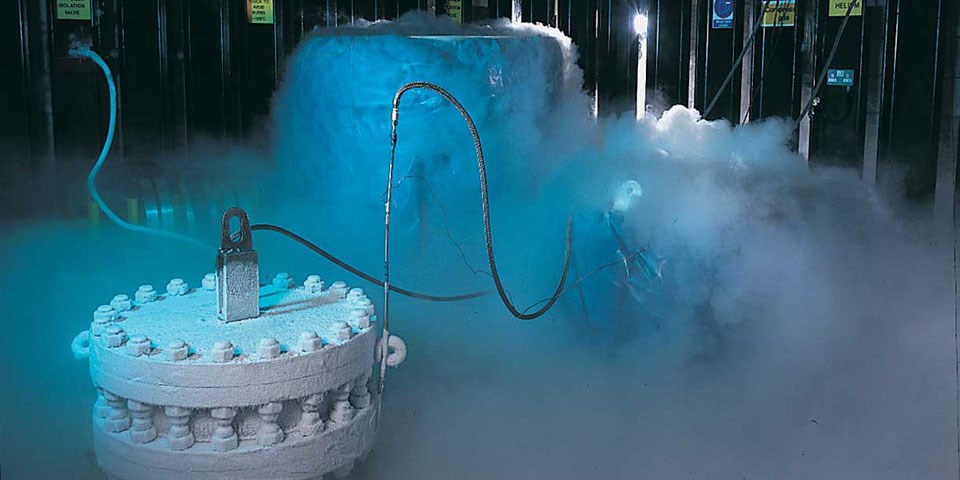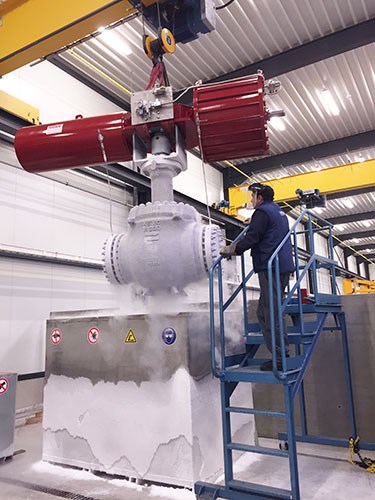Messrs Batra and Suzuki start their discussion with a report on a valve incident from Ewald Soller, who is Team Leader Mechanical/Valves at TGE Gas Engineering GmbH.
He is quoted as saying:
“Ball valves were purchased for an LNG terminal project and successfully passed a witnessed factory acceptance testing (FAT) to BS6364. In the field the required leakage rates could not be achieved once installed.
Trouble shooting led to the test method itself. The test method required by BS6364 cools from the outside in whereas under real conditions the process cools from the inside out. Therefore during the test the body is contracting around the trim where in the field the trim contracts first. As a result some types of valves can seal during the test but cannot replicate their results in the field. In this case the standards allowed a valve to pass FAT that could not seal in the field.
Although additional insulation was added and extra stabilization time allowed to try to cool the trim adequately, eventually it was necessary to replace the position seated ball valves with torque seated ball valves in order to get the required shutoff. This led to changing the internal requirements for ball valves above and beyond meeting BS6364 to ensure the required results were achieved.”
This experience in the real world illustrates just how important this subject matter is when the reliability of isolation valves can literally be the only thing standing between safety and catastrophic failure, say the authors.
Drawbacks in the standards
The two experts then look at the three standards most widely used for cryogenic testing of valves and outline the general testing procedure found in all of them. They then turn their attention to the drawbacks, such as the method of cooling.
They note that in actual cryogenic service, the cryogenic liquid flows through the valve which is insulated on the outside. However, the testing standards demand cooling by immersion in liquid nitrogen and monitoring of the body/bonnet temperature.
In effect, therefore, immersion in liquid nitrogen basically helps in body contraction and hence helps the valve to achieve a tighter shut-off.
Another point they raise concerns cavity relief testing. The standards dictate the need for cavity relief but do not propose any method for testing the cavity relief.
They also bring up the point of directional testing. It appears that whilst in practice some cryogenic valves may be installed at a certain angle from the vertical due to piping layout constraints, none of the testing standards requires directional testing. In other words, testing of the valve installed at an angle from the vertical in the testing rig.
However, this directional testing is required to certify the performance of the valve packing, stem bushings and bearings and gear train when the valve installation is not limited to the vertical position only.
The authors then move on to the issue of how leakage is measured. There is, they write, no consistency in the amount of leakage rates (internal seat leakage and external leakage to the atmosphere via body/bonnet and gland packings) specified in the available testing standards.
This means that end users and inspectors attending factory approval tests are often confused about leakage rates. Since it is difficult or even impossible to achieve zero leakage rates even with soft seated ball or torque seated ball, there is always a question as to how much leakage rate is reasonable.
Time to revisit
Messrs Batra and Suzuki conclude their article by stating that it is neither their intention nor capability to challenge international standards which have been written by industry experts based on years of experience.
However, valves in LNG service are very special valves and need dedicated attention for design, selection and testing.
These valves handle extremely flammable liquids and any valve failure could lead to catastrophic failure and operation downtime.
Therefore, they perceive a need to revisit the requirements stated in the available testing standards to evaluate if the testing simulates the actual working conditions of the valve.
Simply sitting and waiting for an accident to happen which will prompt a standard update is not acceptable, they conclude.




